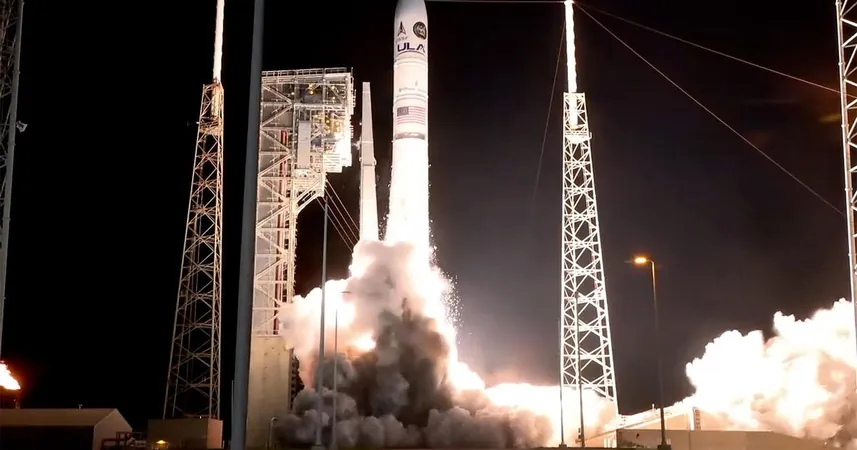
Vulcan Rocket Soars: ULA's Game-Changer for Military Space Missions!
2025-08-13
Author: Yan
In an exhilarating show of power, the United Launch Alliance (ULA) unleashed its first operational Vulcan rocket on Tuesday, marking a defining moment in the realm of military space exploration. This launch is not just a spectacle; it's the inaugural flight sanctioned by the U.S. Space Force for ULA’s cutting-edge launcher that aims to replace the aging Atlas V and retired Delta rockets.
Standing at an astonishing 198 feet, the Vulcan is a titan of modern rocketry, equipped with four solid-fuel strap-on boosters that supercharge its launch. At precisely 8:56 PM EDT, its two methane-fueled BE-4 engines roared to life, catapulting the rocket off Cape Canaveral Space Force Station with nearly 3 million pounds of thrust, mesmerizing onlookers with a dazzling display.
As the Vulcan arched into the night sky over the Atlantic Ocean, it showcased a mesmerizing plume of exhaust visible for miles. Just 90 seconds into the flight, the strap-on boosters were released, followed shortly by the separation of the rocket’s first stage, paving the way for the Centaur's second stage to continue the mission.
In a move befitting military protocol, ULA's commentary on the mission ceased once the Centaur's engines ignited, keeping the remainder of the flight under wraps. However, sources confirm that two significant satellites were on board: a classified military spacecraft and the experimental Navigation Technology Satellite 3 (NTS-3). The latter aims to test advanced atomic clocks and navigation tech that promises to revolutionize GPS for military and commercial users alike.
NTS-3, a pioneering venture since the early GPS days of the 1970s, will orbit at 22,300 miles above the equator and is designed to improve signal delivery through a sophisticated phased array antenna, catering to a wide range of users.
Joanna Hinks, an aerospace engineer at the Air Force Research Laboratory, emphasizes the integral role GPS plays in everyday life, hinting at the transformative potential of NTS-3: “We’ll be experimenting with technologies to continually enhance GPS, ensuring it remains the gold standard our military needs.”
This monumental launch doesn't just symbolize ULA's transition into the future; it's a leap forward for national security. As the Vulcan becomes the backbone for critical military payloads, it stands to elevate ULA’s credibility in the competitive space market, especially as SpaceX continues to dominate with its Falcon fleet.
ULA President Tory Bruno highlights the Vulcan's unique design, tailored for heavy military payloads and high-stakes missions. With plans to launch nine flights as early as 2025, ULA is gearing up to cement its status as a leader in space launch capabilities.
In the world of space, adaptability and innovation reign supreme. The Vulcan rocket is a perfect blend of the two, effortlessly destined to dispatch valuable government satellites into hard-to-reach orbits, ensuring that the U.S. maintains a strategic advantage in military operations and technological supremacy.




 Brasil (PT)
Brasil (PT)
 Canada (EN)
Canada (EN)
 Chile (ES)
Chile (ES)
 Česko (CS)
Česko (CS)
 대한민국 (KO)
대한민국 (KO)
 España (ES)
España (ES)
 France (FR)
France (FR)
 Hong Kong (EN)
Hong Kong (EN)
 Italia (IT)
Italia (IT)
 日本 (JA)
日本 (JA)
 Magyarország (HU)
Magyarország (HU)
 Norge (NO)
Norge (NO)
 Polska (PL)
Polska (PL)
 Schweiz (DE)
Schweiz (DE)
 Singapore (EN)
Singapore (EN)
 Sverige (SV)
Sverige (SV)
 Suomi (FI)
Suomi (FI)
 Türkiye (TR)
Türkiye (TR)
 الإمارات العربية المتحدة (AR)
الإمارات العربية المتحدة (AR)